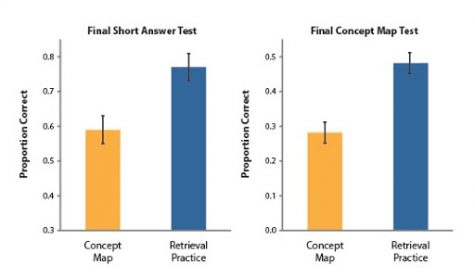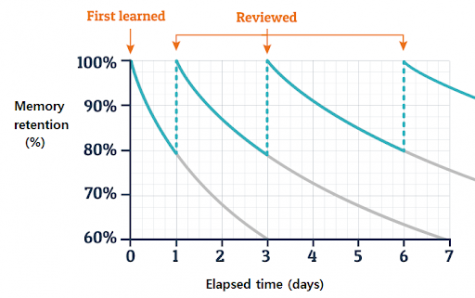Is Studying as Complicated as it Seems?

Studying can be done in a number of ways, but what does psychology tell us about certain methods?
August 9, 2020
By the time students enter high school, they have had their share of quizzes and tests. Chances are, they have experimented with numerous ways of preparation. Although repetitive reading and note-taking are the most popular learning strategies, these methods do not always lead to desirable test outcomes. This issue leads students to doubt their academic ability. It may also make students wonder, “How should I be studying?” Active learning methods are best for retention and improving grades.
Active learning involves various methods of long-term memory retention, rather than simple memorization. In the popular 2015 movie Inside Out, Riley’s mind is represented as a large storage space full of memories stored in spheres. When she thinks about a memory, it is pulled from the memory storage space and replayed like a video in her mind. Active study methods are similar to Riley’s thought process because she retrieved information that was already stored in her brain. With that in mind, let’s dive into a more in-depth review of how to utilize effective study methods.
Utilizing retrieval (active recall) is an easy and beneficial way to advance long-term retention. This method reveals the strengths and weaknesses with what is being learned. Retrieval practice helps students connect ideas and concepts from what they have learned and transfer knowledge between topics. The first step to studying with retrieval practice is to read through notes or a chapter from a textbook. Then, put away the materials and attempt to recall as many facts and concepts as possible from the text. It may help to write things down or create a concept map, or a diagram that illustrates the relationships between different concepts. If something cannot be remembered, that’s okay! The point of this exercise is to process new information and discover memory gaps. This method requires lots of patience and brain power, but the studies below will prove why it will have a positive impact on learning and ultimately lead to a higher grade point average.
In the past decade, numerous studies have been constructed to test how well students who use retrieval learning perform on tests. Jeffery Karpicke is an associate professor of psychological science at Purdue University. In 2016, he designed an experiment to test the effectiveness of active recall. The experiment consisted of two groups of students reading through science articles. One group read an article once, then tried to actively recall all the information they remembered by creating a concept map. The second group created the concept maps while reading through the text. The groups spent the same amount of time using their assigned methods. Then, they completed a test to see how much they learned. The results showed that using retrieval led to higher scores. This is just one of many studies that determined active recall methods are more effective than traditional learning methods.

Now that retrieval learning has been explained and the science behind it has been established, let’s talk about how to stay focused while studying. The Pomodoro Technique was developed by Francesco Cirillo in the late 1980s. It got its name from the tomato-shaped timer that was popular back then. The technique requires a 25 minute period of work, then a five-minute break. After repeating this cycle four times, a 20-minute break is taken. Doing this decreases burnout, while the shorter timeframe increases productivity. It also makes it easier to plan out specific tasks to do and predict how long the work will take. There are apps available for IOS and Android users that are specifically for studying with the Pomodoro Technique, such as Focus Keeper and PomoDone. With the combination of retrieval practice and the Pomodoro Technique, no time will be wasted when working or studying.
With all the talk about retrieval learning, let’s look at how to space out learning sessions. Hermann Ebbinghaus was a German psychologist who created the Ebbinghaus Forgetting Curve. The curve shows how fast people forget information. The data from the graph below shows that most forgetting happens within the first hour of learning. That makes reviewing new facts as soon as possible crucial for retention. During the first review, organizing materials and identifying memory gaps is the main goal. The initial review helps with short term memory, but long-term learning calls for review sessions over a longer period of time. Most information is forgotten after one week of learning, so remember to always review and reexamine!

By learning about the scientifically proven ways to learn, boosting grades and learning will become easier. With retrieval learning, the Pomodoro Technique, and the Ebbinghaus Forgetting Curve in mind, preparing for tests and quizzes will be simpler and more effective.
Works Cited:
Karpicke, Jeffery D. “A Powerful Way to Improve Memory.” American Psychological Association,
American Psychological Association, June 2016,
www.apa.org/science/about/psa/2016/06/learning-memory.
Karpicke, Jeffrey D, and Janell R Blunt. “Retrieval Practice Produces More Learning than
Elaborative Studying with Concept Mapping.” Science, American Association for the
Advancement of Science, 11 Feb. 2011,
science.sciencemag.org/content/331/6018/772.full.
Karpicke, Jeffrey D, and Henry L Roediger. “The Critical Importance of Retrieval for Learning.”
Science, American Association for the Advancement of Science, 15 Feb. 2008,
science.sciencemag.org/content/319/5865/966.full.
Nowell, David D. “Manage Procrastination With the Pomodoro Technique.” Psychology Today,
Sussex Publishers, 2 July 2013,
www.psychologytoday.com/us/blog/intrinsic-motivation-and-magical-unicorns/201307/ma
nage-procrastination-the-pomodoro-technique.
Wittman, John. “The Forgetting Curve.” CSU Stanislaus,
https://www.csustan.edu/sites/default/files/groups/Writing%20Program/forgetting_curve.p
df.


